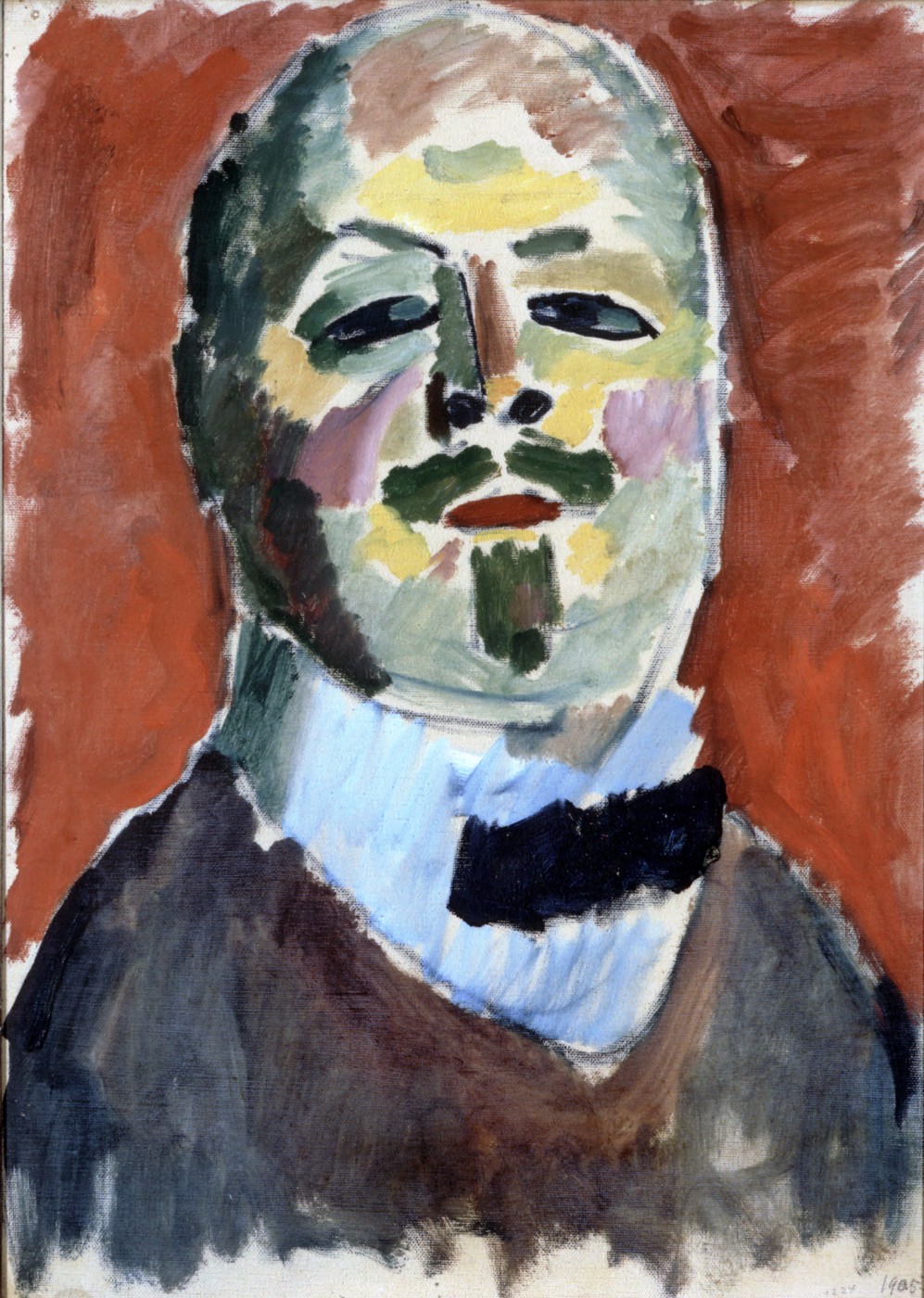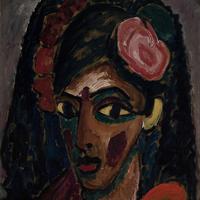More about Alexej von Jawlensky
Works by Alexej von Jawlensky

Contributor
As a teenager, Alexei Georgevitsch von Jawlensky attended the Moscow World Exposition, and it was, to quote a Disney song, "a whole new world."
Although at twenty he served as Lieutenant in Moscow's Samogitian Infantry, his heart wasn't in it, so he gave up his fairly well-established military career to pursue his art. He studied for a time in St. Petersburg with Il’ya Repin, but he tired of the Russian Realist style. Living in Imperial Russia just didn't provide the opportunities or the creative freedom he needed to express himself. He moved to Munich in 1896 to study with Anton Ažbe, which is where he befriended artist Wassily Kandinsky, who influenced his style greatly. A 1905 trip to France led to a working relationship with Henri Matisse, whose "flat expanses of unmodulated color" similarly inspired Jawlensky's painting technique.
In Munich, he was vice-president of the Neue Künstlervereinigung München (NKvM), an association for artists which began at the home of fellow artist Marianne Werefkin. At its second exhibition, Kandinsky raised the hackles of locals dedicated to German national pride by including artists from all over Europe, with an exhibition catalogue including writing by Cubist artist Henri le Fauconnier and Symbolist painter Odilon Redon (both Frenchmen). Kandinsky understood, that expressionism, like many art movements, would have to be "transnational." G. J. Wolf nearly blew a gasket in Die Kunst für Alle: "The beautiful and culturally renowned name of Munich is becoming a roost for an artists’ association of mixed Slavic and Latin elements…There is not one Munich painter amongst them."
In an aesthetic reaction against NKvM, another group emerged, the Blaue Reiter (Blue Rider), in which Jawlensky also participated, with Paul Klee and Franz Marc. The name's meaning is vague, but it sounds cool and, like a good garage band, that was what mattered. Blue, in association with mysticism, stood for the Divine Being. Later, Jawlensky organized another group, the "Blue Four," with Kandinsky, Klee, and Lyonel Feininger.
Jawlensky would not have become a painter without the devotion of Werefkin, who developed the theoretical plan for their work. Between 1896 and 1906, the master Russian painter Werefkin took a hiatus from painting in order to teach Jawlensky, her love interest, how to paint. Werefkin was connected with Russia and the artists from that world, such as Marc Chagall, but she was also familiar with Western art, making her a "bridge between the local art scene and that in Germany." In a rare public speech at the Vilnius Art Society, she states the creed of the "Blue Rider" art group: to express all feelings and impressions in the language of lines and colors, to recognize that the foundation of art is in the chain of representations connected to symbols, and to appreciate the work of Vincent van Gogh, Henri Matisse, Pablo Picasso, and their friend Kandinsky. She and Jawlensky, she added, contrary to other artists, rely mainly on shapes drawn from real life, transforming them into abstractions only "for the purposes of our faith."
We don't need to be shocked, then, that the Nazis threw Jawlensky into their huge dogpile of "degenerate" artists unfit for the pure eyes of their subjects. Jawlensky's works were abstract, and based on the interpretation of a female vanguard leader who collaborated with Jews and people of other nationalities in an increasingly mixed European scene. Basically everything Hitler hated.
Later in life, Jawlensky had a son, Andreas, with Hélène Nesnakomoff, Werefkin's former maid. They were married shortly after Andreas was born. Eventually, severe arthritis made it impossible for him to paint so he dedicated his creative efforts to dictating his memoirs.
Sources
- Barnett, Vivian Endicott. “Russian Artists in Munich and the Russian Participation in Der Blaue Reiter." In Russian Modernism: Cross Currents of German and Russian Art, 1907-1917, edited by Konstantin Akinsha, 61–74. Munich: Prestel, 2015.
- Behr, Shulamith. Women Expressionists. London: Phaidon, 1988.
- Belgin, Tayfun. Alexej von Jawlensky: Eine Künstlerbiographie. Heidelberg: Umschau/Braus, 1998.
- Goldmann, Klaus. The Safekeepers: A Memoir of the Arts of the End of World War II. Berlin: Walter de Gruyter GmbH & Co., 2015.
- von Jawlensky, Alexej, Maria Jawlensky, Lucia Pieroni-Jawlensky, and Angélica Jawlensky. Alexej von Jawlensky: catalogue raisonné of the oil paintings. London: Sotheby's, 2003.
- Levin, Amy K. Gender, Sexuality and Museums: A Routledge Reader. London: Routledge, 2010.
- Wünsche, Isabel. The Routledge Companion to Expressionism in a Transnational Context. London: Routledge, 2018.
- Friedman, Samantha. "Henri Matisse." MoMa.org https://www.moma.org/artists/3832 Accessed 1/7/2021.
Featured Content
Here is what Wikipedia says about Alexej von Jawlensky
Alexej Georgewitsch von Jawlensky (Russian: Алексе́й Гео́ргиевич Явле́нский, romanized: Alekséy Geórgiyevich Yavlénskiy; 13 March 1864 – 15 March 1941), surname also spelt as Yavlensky, was a Russian expressionist painter active in Germany. He was a key member of the New Munich Artist's Association (Neue Künstlervereinigung München), Der Blaue Reiter (The Blue Rider) group and later Die Blaue Vier (The Blue Four).
Check out the full Wikipedia article about Alexej von Jawlensky











